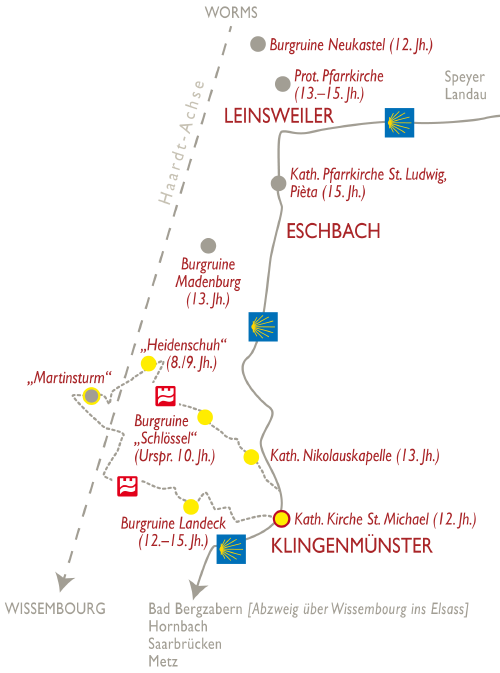
Klingenmünster
On the paths of the pilgrims of St. James
Palatinate | South Route on the Haardt Axis
Church St. Michael
The medieval Catholic Church of St. Michael, former Benedictine monastery (12th century) is a reference point in the European model project and was equipped with an information board on September 19, 2021. In addition, the “Klingenmünster Starry Path Loop” was inaugurated to explore the medieval monuments in Klingenmünster.

Fig: Klingenmünster surroundings
The 9.5 km loop connects four other medieval reference points and the Martin Tower on the Treutelskopf. The varied hiking trail mostly follows the “Burgenweg” markings and is described in a flyer. Exciting videos with background information are included in the flyer via QR code.
St. Nicholas Chapel
N 49° 8’ 46.76", E 8° 0’ 51.4"
13. Century
Castle ruin “Schlössel”
N 49° 9’ 1.83", E 8° 0’ 24.83"
(origin 10th c.), remains of residential tower (11th/12th c.)
“Heidenschuh”
N 49° 9’ 20.52", E 7° 59’ 56.76"
Remains of a refuge (8th/9th c.), two section walls, the outer one with a ditch, sealed off a (formerly walled) mountain nose.
Landeck castle ruin
N 49° 8’ 28.71", E 8° 0’ 22.94"
12-15 c.
Pilgrimage stamps are available for all five medieval cultural monuments: The pilgrimage stamps for St. Nicholas Chapel and St. Michael’s Catholic Church are available across from the church at Stiftsgut Keysermühle. The pilgrimage stamps for “Schlössel”, “Heidenschuh” and “Landeck” are available at the Burgschänke of the Landeck castle ruins.





The new information board at the catholic church St. Michael

Team spirit
The Regional Association of Saarbrücken manages the cross-border development of the project in a process-oriented manner. The path signs are created within the framework of qualification measures for people looking for work. Cooperation partners are the St. James Societies (Rhineland-Palatinate, Saarland, Lorraine, Alsace), many counties, cities, municipalities, church and cultural tourism institutions along the routes of the project area as well as the Institute for European Cultural Routes of the Council of Europe. In 2018/19, the project provided a contribution to the European Heritage Year.
“With this model project, we would like to inspire the current search movement of many people for meaning in life and (European) values with small gestures. Meaning, compassion and solidarity experience an unforeseen importance in times of crisis. To these current topics within the society, the idea of the star way can make a contribution. Pilgrimage means mindful walking and the search for knowledge, and this also applies to everyday life. In the extremely multifaceted cultural landscapes of our homeland and especially in the medieval churches along the way, one receives many suggestions for this. Spirituality is a basic human need, and this can be read and rediscovered in particular from the myth of the paths of the pilgrims of St. James to this day. A special thank you goes to Günter Nuss and Klaus Frey from the Burg Landeck Foundation and their cooperation partners, who have worked with great commitment to make this vision in Klingenmünster comprehensible for locals and guests,” explained the head of the project Peter Michael Lupp from the Regional Association of Saarbrücken during his presentation in Klingenmünster.
The ceremonial inauguration of the information board took place in the presence of the District Administrator of the Südliche Weinstraße district, Dietmar Seefeldt, the local mayor Kathrin Flory, Pastor Marco Gabriel and Karl Unold from the St. James Society Rhineland-Palatinate-Saarland e.V., as well as the initiators on site, who were particularly committed.












